Ingredient Noodle

What are some popular Japanese dishes ?
Japanese cuisine is known for its exquisite flavors, meticulous preparation, and beautiful presentation. Some popular dishes include sushi, ramen, tempura, udon, and okonomiyaki. Sushi comes in various forms such as nigiri, sashimi, and maki. Ramen is a noodle soup with different broths and toppings. Tempura is a fried dish with a light batter. Udon is thick noodles served hot or cold with various toppings. Okonomiyaki is a savory pancake with diverse ingredients. Each region in Japan has its own specialties and unique flavors to explore.

What is the difference between ramen and udon noodles ?
Ramen and udon are two popular Japanese noodle dishes with unique flavors, textures, and cultural significance. Ramen is made from wheat flour, water, salt, and kansui, resulting in elastic and chewy noodles. It is typically served in a meat-based broth flavored with soy sauce, miso, or seafood, and topped with pork, menma, scallions, nori, and a soft-boiled egg. Udon, on the other hand, is made primarily from wheat flour and water, producing thicker and smoother noodles. Its broth is usually clear and light, made from kombu and shiitake mushrooms, and often served hot or cold with simple toppings like tempura, green onions, or grated ginger. Ramen originated in China but became popular in Japan during the early 20th century, evolving into a staple of Japanese cuisine. It has numerous regional variations across Japan, such as Sapporo's miso ramen, Hakata's tonkotsu ramen, and Tokyo's soy sauce-based ramen. Ramen shops can be found everywhere in Japan, from high-end establishments to quick street food stalls, reflecting its deep integration into daily life. Udon has been part of Japanese cuisine for centuries and is traditionally associated with Sanuki (now Kagawa Prefecture), known as the "Udon Kingdom." While udon is typically served in a simple broth or chilled with a dipping sauce, there are also hot pot variations like nabe and kitsune (fox) udon. Udon is often considered comfort food in Japan and is frequently consumed during cold weather or as a quick meal due to its ease of preparation. In conclusion, ramen and udon offer distinct experiences for those who enjoy them. Ramen provides a hearty and filling meal with complex broths and diverse toppings, while udon offers a cleaner taste with simpler broths and toppings, focusing on the pure enjoyment of the noodle itself. Both have their place in Japanese cuisine and continue to captivate noodle enthusiasts around the world.

What are some unique ingredients commonly used in French desserts ?
French desserts are renowned for their exquisite taste and delicate textures, which are largely due to the unique ingredients used in their preparation. These include vanilla beans, almond meal, cream, butter, lemon zest, and kirsch. Each ingredient plays a crucial role in enhancing the flavor, aroma, and texture of French desserts. Understanding the importance and usage of these ingredients can help you appreciate the artistry behind French pastry making and even try your hand at creating your own delectable treats.

How do I know if a product is truly organic ?
Identifying truly organic products requires looking for certification labels, checking the ingredient list, researching the manufacturer or brand, and visiting farmers markets and local stores. Certification labels such as USDA Organic, Euro-leaf, and JAS indicate that the product meets specific standards for organic production. The ingredient list should indicate that all ingredients are organic and free from GMOs. Researching the manufacturer or brand can provide information about their farming practices and quality control processes. Visiting farmers markets and local stores allows you to ask questions about the products and see them firsthand. By following these tips, you can ensure that you are getting genuine organic products that are free from harmful chemicals and pesticides.

How do professional bartenders measure ingredients for consistency ?
Professional bartenders use a variety of tools and techniques to measure ingredients consistently. Accuracy is crucial for maintaining the same flavor profile and balancing different tastes in cocktails. Efficiency is also important, as it speeds up drink-making and allows bartenders to focus on customer interaction. Jiggers are commonly used tools for measuring both large and small quantities of liquids. Measuring spoons are used for smaller amounts like bitters or syrup. Digital scales are used for precise measurements by weight, especially for ingredients like fruit juices or syrups. Pour spouts and containers help control the flow of liquids to reduce spillage and waste. Standardization processes such as recipe cards, batching, and taste testing are also essential. Recipe cards include detailed measurements for each ingredient, helping new bartenders learn quickly and maintain consistency. Batching involves pre-mixing a large volume of a single cocktail ingredient or an entire recipe, saving time during busy shifts and ensuring uniformity. Taste tests are crucial even with precise measurements, as bartenders adjust recipes based on customer feedback and ingredient freshness. In conclusion, professional bartenders rely on a combination of tools, techniques, and standardized processes to measure ingredients consistently. This ensures that they can replicate the perfect cocktail every time, providing a high-quality experience for their customers.
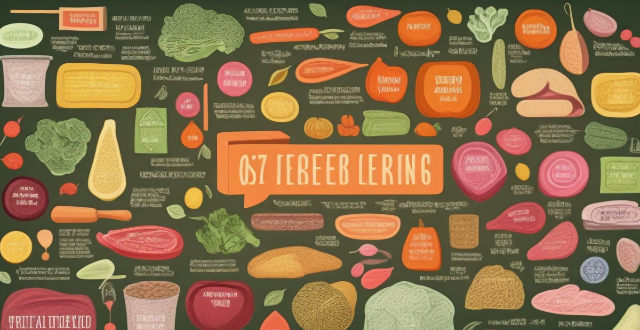
How does food labeling contribute to food safety ?
Food labeling is crucial for food safety as it provides consumers with essential information. It includes ingredient lists, nutritional information, expiration dates, manufacturing details, storage instructions, certification marks, allergy warnings, country of origin, precautionary statements, and environmental impact information. Proper labeling practices help identify ingredients, understand nutritional values, recognize potential risks, and make informed decisions about food consumption.
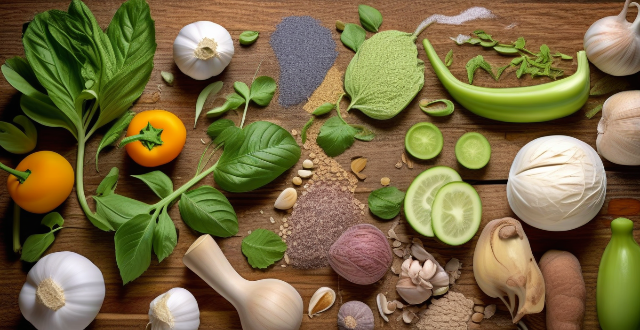
What ingredients are commonly used in Mexican cooking to create its unique flavor profile ?
The article provides an overview of the key ingredients used in Mexican cooking, including chili peppers like ancho, jalapeño, serrano, and habanero; herbs and spices such as cumin, coriander, oregano, and cilantro; and other ingredients like tomatoes, onions, garlic, lime juice, epazote, and hominy. It explains how these ingredients contribute to the distinctive flavor profile of Mexican cuisine and encourages readers to experiment with creating authentic Mexican meals at home.
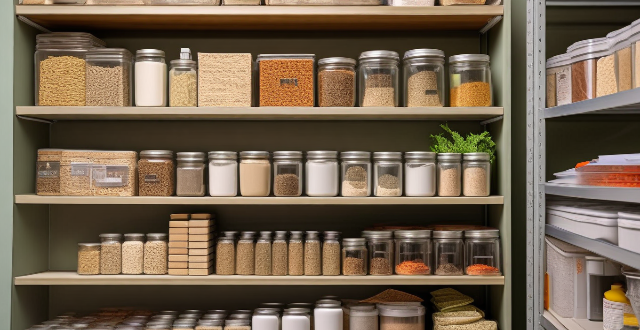
How long do homemade natural cleaners typically last before they lose their potency ?
Homemade natural cleaners' shelf life depends on factors like ingredients, storage, and concentration. To extend their lifespan, use high-quality ingredients, store properly, label with dates, avoid cross-contamination, and consider adding natural preservatives.

What are some tips for beginners in baking ?
Baking is a rewarding hobby that can bring joy and delicious treats to your life. Here are some tips to help beginners get started: 1. Read the recipe thoroughly before starting. 2. Use the right ingredients, fresh and as specified in the recipe. 3. Prep your ingredients beforehand. 4. Follow the recipe steps carefully. 5. Practice patience during the baking process. 6. Learn from your mistakes and keep practicing.

What are the key differences between classic and modern cocktail styles ?
Cocktail styles have evolved over time, with classic cocktails representing traditional recipes and techniques, while modern cocktails often showcase innovative ingredients and presentation methods. Classic cocktails are known for their simplicity, limited ingredient list, standard measurements, traditional garnishes, and historical significance. Examples include the Martini, Old Fashioned, and Daiquiri. Modern cocktails, on the other hand, feature innovation, complexity, craft methods, visual appeal, and locally sourced ingredients. Examples include the Earl Grey MarTEAni, Smoked Old Fashioned, and Lavender Lemon Drop. In summary, classic cocktails pay homage to the roots of mixology, while modern cocktails celebrate creativity and the ongoing evolution of the craft. Both styles offer a unique drinking experience and cater to different preferences among cocktail enthusiasts.

What are some common mistakes people make when baking cookies ?
Baking cookies is a beloved pastime for many, but it can also be fraught with pitfalls. Here are some common mistakes people make when baking cookies: Not measuring ingredients accurately using volume measurements instead of weight, incorrect use of measuring tools, not sifting dry ingredients, overmixing or undermixing the dough, handling the dough too much, not preheating the oven, not using an oven thermometer, placing cookies too close together, using inferior quality chocolate or nuts, substituting ingredients without adjustment, not bringing eggs and butter to room temperature, underbaking or overbaking, not rotating the cookie sheet, baking at the wrong temperature, storing cookies improperly, and not considering shelf life. By avoiding these common mistakes, you can elevate your cookie game and enjoy consistently delicious treats every time you bake.
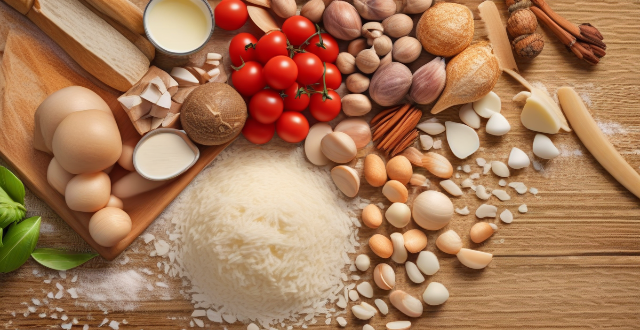
What kind of ingredients are commonly used in Japanese cuisine ?
Japanese cuisine is known for its unique flavors, fresh ingredients, and beautiful presentation. The most commonly used ingredients in Japanese cooking include white rice, brown rice, sweet rice, tuna, salmon, squid, shellfish, chicken, beef, pork, cabbage, eggplant, green onions, mushrooms, soy sauce, miso, udon noodles, soba noodles, ramen noodles, rice vinegar, sesame oil, nori, wasabi, and pickled ginger. These ingredients combine to create the diverse and delicious flavors that make Japanese cuisine so beloved around the world.

What are the key ingredients in Indian cooking ?
Indian cuisine is known for its rich flavors and diverse dishes. The key ingredients that make Indian cooking unique are spices, herbs, ghee, lentils, rice, yogurt, nuts and seeds, and bread. These ingredients add flavor, color, and aroma to the dishes and create authentic and delicious Indian cuisine.

What are the best destinations in Asia for foodies ?
Asia is a haven for food lovers with its diverse range of cuisines. Here are the best destinations in Asia for foodies: Tokyo, Japan; Bangkok, Thailand; Penang, Malaysia; Hong Kong; Seoul, South Korea; Mumbai, India; Ho Chi Minh City, Vietnam; Taipei, Taiwan; Osaka, Japan; and Singapore. Each destination offers unique and delicious dishes that are sure to satisfy any food enthusiast's cravings.

How does the use of chilies contribute to the distinctive taste of Mexican food ?
Chilies play a pivotal role in Mexican cuisine, contributing heat, flavor complexity, color, and cultural significance. They offer varying intensities of spiciness, from mild to very hot, and their fruity or earthy flavors complement other ingredients. Visually appealing with vibrant colors, chilies also have nutritional benefits like antioxidants and metabolism boost. They are versatile in cooking, used fresh, dried, or smoked, and pair well with acidic and herbal ingredients. Chilies are integral to traditional dishes like enchiladas and mole sauce, showcasing their essential role in defining the unique taste profile of Mexican food.

What are some good ideas for quick lunches ?
When it comes to quick lunches, there are plenty of options that are both healthy and satisfying. Here are some ideas: 1. Sandwiches: Peanut Butter and Jelly, Turkey and Cheese, Hummus and Veggie Wrap 2. Salads: Greek Salad, Chicken Caesar Salad, Quinoa Salad 3. Soups and Stews: Tomato Soup, Chicken Noodle Soup, Vegetable Stew 4. Pasta Dishes: Spaghetti with Marinara Sauce, Macaroni and Cheese, Pasta Salad 5. Breakfast for Lunch: Egg and Cheese Sandwich, Oatmeal, Yogurt Parfait These are just a few ideas to get you started on your quick lunch journey. Remember to mix and match ingredients to create your own unique combinations!
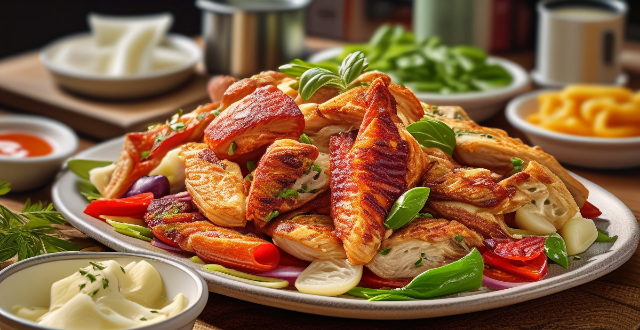
What are some easy and quick low-calorie meal prep ideas for busy weeknights ?
Easy and quick low-calorie meal prep ideas for busy weeknights include grilled chicken salad jars, zucchini noodle bowls, quinoa salad with roasted vegetables, and turkey lettuce wraps. These meals can be prepared ahead of time and stored in the fridge for easy assembly or reheating on busy nights. Planning ahead and choosing recipes that are both nutritious and satisfying is key to successful meal prep.

What are the best food destinations around the world ?
Food is an integral part of any culture, and exploring different cuisines is a great way to experience a country's traditions and customs. Here are some of the best food destinations around the world: 1. Italy - Pizza and Pasta in Naples, Gelato in Florence 2. Japan - Sushi in Tokyo, Ramen in Sapporo 3. France - Croissants in Paris, Baguettes in Lyon 4. Mexico - Tacos in Mexico City, Ceviche in Cancun 5. India - Curry in Mumbai, Chai Tea in Delhi

Where can I find a fine dining experience in Tokyo, Japan ?
Tokyo is famous for its diverse culinary scene, offering a wide range of fine dining experiences that cater to various tastes and preferences. Whether you're in the mood for traditional Japanese cuisine or international fare, there are plenty of options to choose from. Here are some of the top places to find a fine dining experience in Tokyo: ## Traditional Japanese Cuisine ### Kohju - **Location**: Ginza district - **Cuisine**: Kaiseki (traditional multi-course meal) - **Highlights**: Elegant atmosphere, seasonal ingredients, skilled chefs - **Price Range**: High-end ### Ishikawa - **Location**: Shibuya district - **Cuisine**: Sushi (raw fish served with vinegared rice) - **Highlights**: Fresh seafood, expert sushi craftsmanship, intimate setting - **Price Range**: Moderate to high-end ## International Cuisine ### Quintessence - **Location**: Shiodome district - **Cuisine**: French - **Highlights**: Innovative dishes, impeccable service, stunning views of Tokyo Bay - **Price Range**: High-end ### Narisawa - **Location**: Minami Aoyama district - **Cuisine**: Modernist Japanese with international influences - **Highlights**: Creative presentations, locally sourced ingredients, artistic plating - **Price Range**: High-end ## Vegetarian/Vegan Options ### Yohji - **Location**: Harajuku district - **Cuisine**: Vegan Japanese fusion - **Highlights**: Flavorful plant-based dishes, unique flavor combinations, cozy atmosphere - **Price Range**: Moderate ### Sougo - **Location**: Roppongi district - **Cuisine**: Vegan Italian - **Highlights**: Hearty pastas, authentic Italian flavors, friendly staff - **Price Range**: Moderate to high-end ## Budget-Friendly Options ### Ichiran Ramen - **Location**: Multiple locations throughout Tokyo - **Cuisine**: Ramen (noodle soup) - **Highlights**: Customizable broth and toppings, fast service, affordable prices - **Price Range**: Affordable ### Tenya - **Location**: Multiple locations throughout Tokyo - **Cuisine**: Tendon (tempura over rice) - **Highlights**: Crispy tempura, generous portions, quick meals on the go - **Price Range**: Affordable No matter your budget or dietary preferences, Tokyo offers a diverse array of fine dining experiences that will leave you satisfied and eager to return for more.

How do I know if a product is truly gluten-free ?
Gluten-free products are becoming increasingly popular, but it's important to know how to identify whether a product is truly gluten-free. Here are some tips: 1. Check the Label 2. Look for Certifications 3. Read the Ingredient List 4. Be Wary of Cross-Contamination 5. Trust Reputable Brands 6. Ask Questions

What are the most popular street foods in different countries ?
Street food is a significant aspect of many cultures worldwide, offering diverse flavors and culinary experiences. Here are some of the most popular street foods from different countries: 1. United States: Hot Dogs, Pretzels, Nachos 2. Mexico: Tacos, Elote, Churros 3. Japan: Takoyaki, Okonomiyaki, Yakitori 4. India: Samosas, Pani Puri, Vada Pav 5. Thailand: Pad Thai, Mango Sticky Rice, Som Tam 6. Italy: Pizza al Taglio, Supplì, Gelato 7. China: Jianbing, Baozi, Roujiamo 8. Turkey: Midye Dolma, Simit, Baklava 9. Vietnam: Banh Mi, Bun Cha, Pho 10. Egypt: Falafel, Koshari, Shawarma

How do I choose eco-friendly cleaning products ?
This text provides a comprehensive guide on choosing eco-friendly cleaning products, emphasizing the importance of understanding eco-friendly labels, checking ingredient lists for harmful chemicals, opting for concentrated and reusable packaging options, supporting green brands, and considering homemade cleaners. By following these steps, consumers can make informed choices that contribute to a healthier planet and home environment.

How do I read food labels to ensure I'm making healthy choices ?
To make healthy food choices, understanding food labels is key. Start by checking the serving size and calories per serving. Examine the nutrients listed, including macronutrients, sugar content, and fiber. Look for essential vitamins and minerals. The ingredient list tells you what the product contains, so avoid unnecessary additives. Pay attention to the % Daily Value, focusing on key nutrients like sodium and fat. Check for certifications and understand marketing claims. If you have allergies, check the allergen list and look for warning labels. Finally, check the expiration date. By reading food labels carefully, you can make healthier choices that align with your dietary needs and preferences.

What are the essential items to bring for a scuba diving or snorkeling trip ?
When planning a scuba diving or snorkeling trip, it's important to be prepared with the right gear and equipment. Here are some essential items to consider bringing: ## Scuba Diving ### Personal Gear - **Wetsuit or Drysuit**: Depending on the water temperature, you may need a wetsuit or drysuit to keep warm. - **Fins, Mask, and Regulator**: These are the basic pieces of scuba equipment that you'll need for each dive. - **Dive Computer**: A dive computer helps you track your depth, time, and nitrogen levels. - **Buoyancy Control Device (BCD)**: A BCD helps you adjust your buoyancy underwater. - **Dive Watch**: A watch with a timer function can help you keep track of your dive time. - **Dive Light**: A dive light is useful for exploring underwater caves or for night dives. - **Dive Knife**: A dive knife can be used for safety purposes or to cut through fishing line or nets. - **Dive Boots**: Dive boots protect your feet from sharp rocks and coral. - **Dive Gloves**: Dive gloves protect your hands from cold temperatures and abrasions. ### Safety Equipment - **First Aid Kit**: A first aid kit should include items such as bandages, antiseptic wipes, and pain relievers. - **Signal Whistle**: A signal whistle can be used to attract attention if you need assistance. - **Surface Marker Buoy (SMB)**: An SMB can be deployed to mark your position on the surface while you're underwater. - **Dive Flag**: A dive flag alerts boaters and other water users that there are divers in the area. - **Oxygen Boost**: An oxygen boost can be used in case of decompression sickness. ## Snorkeling ### Personal Gear - **Snorkeling Mask**: A well-fitting mask is essential for clear vision underwater. - **Snorkeling Fins**: Fins help you move more efficiently through the water. - **Snorkeling Vest**: A snorkeling vest provides added buoyancy and comfort while swimming. - **Sun Protection**: Sunscreen, sunglasses, and a hat are important for protecting your skin and eyes from the sun's harmful rays. - **Waterproof Camera**: A waterproof camera allows you to capture memories of your underwater adventures. - **Rash Guard**: A rash guard provides an extra layer of protection against the sun and abrasions. - **Dry Bag**: A dry bag can be used to store your belongings while you're in the water. ### Safety Equipment - **Life Jacket**: A life jacket is important for staying afloat if you become tired or encounter rough waters. - **Whistle**: A whistle can be used to attract attention if you need assistance. - **Water Shoes**: Water shoes provide protection for your feet while walking on rocky or slippery surfaces. - **Floatation Device**: A floatation device such as a pool noodle or kickboard can be used for added stability and support while swimming.

Are there any shopping apps specifically designed for eco-friendly products ?
There are several shopping apps available that are specifically designed for eco-friendly products. These apps allow users to browse and purchase products that are sustainable, organic, and environmentally friendly. Some of the popular shopping apps for eco-friendly products include EcoShopper, GoodOnYou, and Think Dirty. EcoShopper is a shopping app that offers a wide range of eco-friendly products, including organic food, natural beauty products, and sustainable fashion. The app allows users to search for products based on their specific needs and preferences, making it easy to find sustainable alternatives to everyday items. GoodOnYou is a fashion app that rates brands based on their sustainability and ethical practices. The app provides users with information about a brand's environmental impact, labor practices, and animal welfare policies, allowing them to make more conscious purchasing decisions. Think Dirty is a beauty app that helps users identify the ingredients in their cosmetics and personal care products. The app provides information about the safety and environmental impact of each ingredient, allowing users to make more informed decisions about their purchases. In conclusion, these shopping apps are specifically designed for eco-friendly products, making it easier for consumers to make more conscious purchasing decisions. By using these apps, users can support sustainable brands and reduce their environmental impact while still enjoying high-quality products.

Is it safe to use lemon juice as a disinfectant in homemade cleaning recipes ?
Is it safe to use lemon juice as a disinfectant in homemade cleaning recipes? Let's take a closer look at the science behind this question. Lemon juice has a high acidity level, with a pH of around 2, making it effective at breaking down dirt and grime. However, when it comes to killing bacteria and viruses, the acidity alone may not be enough. While lemon juice does have some antimicrobial properties due to its natural compounds like limonene, these are not strong enough to completely disinfect surfaces. In fact, studies have shown that lemon juice is not effective at killing certain types of bacteria like E. coli and Salmonella. Some homemade cleaning recipes call for combining lemon juice with other ingredients like vinegar or hydrogen peroxide. While these combinations may increase the disinfecting power, they still may not be as effective as commercial disinfectants. There are also safety concerns to consider when using lemon juice as a disinfectant. Due to its high acidity, lemon juice can be corrosive to certain surfaces like marble and granite. It can also damage metals over time. Lemon juice can cause skin irritation or burns if it comes into contact with open wounds or sensitive skin. It is important to wear gloves while using it in cleaning solutions. Additionally, some people may be allergic to lemons or their scent, which could trigger an allergic reaction when using lemon juice in cleaning products. If you are looking for natural disinfectants, there are several alternatives to lemon juice such as white vinegar, hydrogen peroxide, tea tree oil, and essential oils like eucalyptus, lavender, and peppermint oils. These alternatives have strong antimicrobial properties and can be added to homemade cleaning solutions for a fresh scent. In conclusion, while lemon juice can be a useful ingredient in homemade cleaning recipes due to its degreasing properties, it should not be relied upon as a sole disinfectant. If you are concerned about germs and bacteria, it is best to use a commercial disinfectant or one of the alternative natural disinfectants mentioned above.

What are some creative ways to use tofu in vegetarian cooking ?
Tofu is a versatile and nutritious ingredient that can be used in a variety of vegetarian dishes. Here are some creative ways to use tofu in your cooking: marinated and grilled tofu skewers, creamy tofu pasta sauce, tofu stir-fry, tofu bao buns, tofu scramble, and tofu dumplings. By incorporating these ideas into your vegetarian cooking, you can enjoy the many health benefits of tofu while exploring new flavors and textures in your meals.

How can I learn about a culture through its cuisine during my travels ?
Exploring a culture through its cuisine during travels can be achieved by embracing local eateries, visiting markets, taking cooking classes, dining with locals, attending food festivals, reading and researching, and asking questions. This immersive experience allows travelers to understand the history, traditions, and essence of a place through every dish and ingredient.

How can schools improve their food safety standards ?
Improving food safety standards in schools is crucial for protecting the health of students and staff. Here are some ways that schools can enhance their food safety practices: 1. Implement a HACCP System 2. Train Staff on Food Safety 3. Use Proper Handling and Cooking Techniques 4. Maintain Cleanliness and Sanitation 5. Enforce Strict Ingredient Sourcing Policies 6. Establish Clear Policies for Illness Reporting 7. Conduct Regular Audits and Reviews